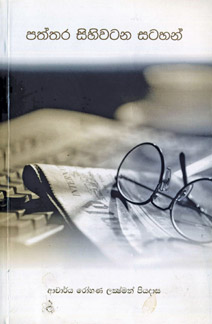Memorable notes on local newspapers

To build a better culture of communication studies in any country
various types of books, both text and supplementary, should appear. This
should be fulfilled not by those who have just tasted the subject at a
periphery level, but by those who have undergone intensive research and
training in the relevant subject areas.
Professor Rohana Luxman Piyadasa, the current Head of the Department
of Mass Communication at Kelaniya University, has often proved his
skills in areas such as training, research and teaching. To his credit
he has written quite a number of learned articles on communication
matters with emphasis on his forte, journalism.
In his latest collection of various notes on local newspaper scene,
he goes as far back as the very beginnings of Sinhala newspapers such as
Lankalokaya and Sarasavi Sandaresa. In the book titled as Pattara
Sihivatana Satahan he brings to the forefront some hidden events in
newspaper industry, hitherto undiscovered aspects of journalism and
their manifold career events. The most significant factor is that he
tries to visualize these events in a socio-cultural milieu. This enables
a student of communication especially on the print medium to discover
more and more factors.
 In the opening episode there is an elaborate discussion on the
controversy as to which Sinhala newspaper was printed and registered
first. The debate had been centred round two newspapers: Lankalokaya and
Lakmini Pahana. In the opening episode there is an elaborate discussion on the
controversy as to which Sinhala newspaper was printed and registered
first. The debate had been centred round two newspapers: Lankalokaya and
Lakmini Pahana.
This is supposed to be towards middle and late 1860s, when the
printing had been introduced by the Dutch though there is evidence to
visualize that several other modes of indigenous printing had been in
vogue. Most scholars discuss matters on appearance of a prayer book and
several religious texts with the introduction of Dutch printing project.
This head paved the way to the gradual growth of printing systems later,
which supposedly triggered off with the appearance of an English
newspaper titled Colombo Journal (in 1832) and the Ceylon Government
Gazette (1803). Professor Piyadasa tries to collate these publications
with an eye into the contents and the intentions embedded in them. This
I felt is a need as a rediscovery into the social history of the
country.
The second episode is centred round the birth of Dinamina, the
Sinahla newspaper. The intention of the compiler of these notes is to
clarify some of the social needs and requirement that had gone into the
moulding of the paper in the hands of learned editors. What a newspaper
editor has to face is depicted in the third note where the main subject
is the attempt to begin a Sinhala newspaper from the Times publication
which was dominated by the English press.
In fact he pinpointed various trends and modes that had gone into the
making of a national newspaper in the hands of varying types of editors
who changed their positions from time to time. As a child I recall how
we were made to grow up with these English newspapers. But with the
advent of the social needs, religious, political and cultural trends the
birth of the Sinhala newspaper Lankapahana came to be a significant
moment in the annals of local newspaper industry.
Lanka Pahanaís Chief Editor D B Dhanapala was a trendsetter for most
periodicals that followed later. Professor Piyadasa, I feel, presents a
synoptic view, but many more could be penned via research findings by
the students of the history of mass media in our country. Together with
these notes the reader too comes across several professions of some
leading Sinhala journalists who performed a yeoman taste to build a
better communication culture in the country.
The touching episode on the function of the celebrity in the field,
Dr Martin Wickramasinghe, the doyen of letters, appears as a significant
contribution to this collection. It is the fourth episode in the
collection, which mainly centres round the personality of Wickramasinghe
as a creative writer cum journalist par excellence.
Then comes several episodes on such subjects as the alternative
newspapers, the appearance of the one time popular Sinhala daily Attha
and the attitudes it created in the minds of the Sinhala reader.
Though not quite in direct tenor of the selections, but due to the
compilerís knowledge in Russian communication studies, Professor
Piyadasa too presented an episode on the press scene in Russia. This, I
felt, was of interest by way of comparing some of the extant political
trends that had gone into the structure of local newspapers. All in all
a student and a teacher of mass communication may find these notes and
episodes are of interesting source material as basic guidance in
journalism.
[email protected]
|



